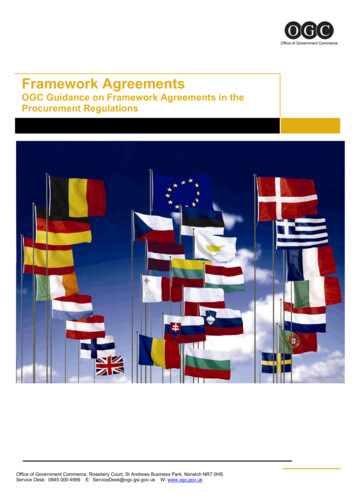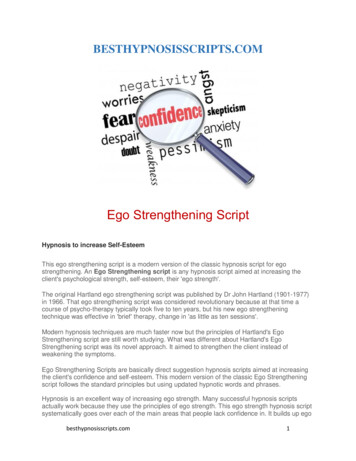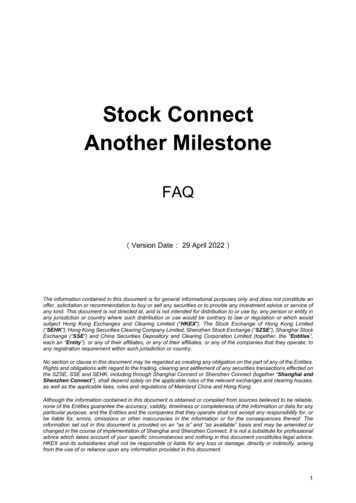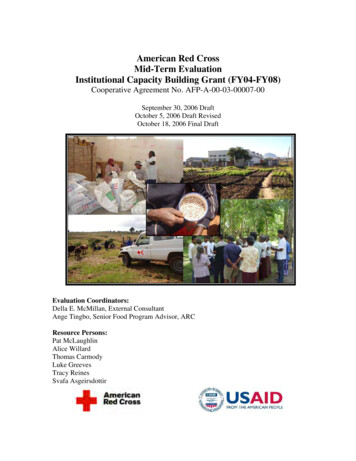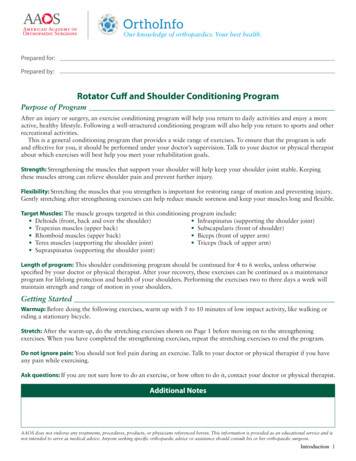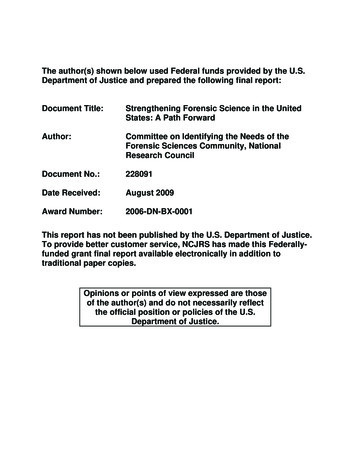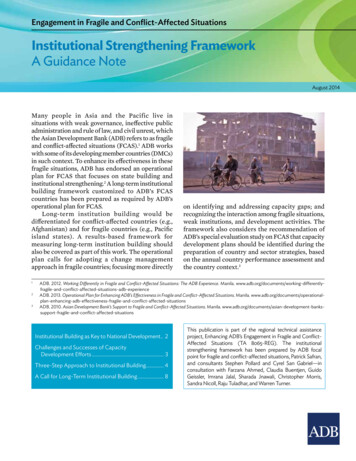
Transcription
Engagement in Fragile and Conflict-Affected SituationsInstitutional Strengthening FrameworkA Guidance NoteAugust 2014Many people in Asia and the Pacific live insituations with weak governance, ineffective publicadministration and rule of law, and civil unrest, whichthe Asian Development Bank (ADB) refers to as fragileand conflict-affected situations (FCAS).1 ADB workswith some of its developing member countries (DMCs)in such context. To enhance its effectiveness in thesefragile situations, ADB has endorsed an operationalplan for FCAS that focuses on state building andinstitutional strengthening.2 A long-term institutionalbuilding framework customized to ADB’s FCAScountries has been prepared as required by ADB’soperational plan for FCAS.Long-term institution building would bedifferentiated for conflict-affected countries (e.g.,Afghanistan) and for fragile countries (e.g., Pacificisland states). A results-based framework formeasuring long-term institution building shouldalso be covered as part of this work. The operationalplan calls for adopting a change managementapproach in fragile countries; focusing more directly123on identifying and addressing capacity gaps; andrecognizing the interaction among fragile situations,weak institutions, and development activities. Theframework also considers the recommendation ofADB’s special evaluation study on FCAS that capacitydevelopment plans should be identified during thepreparation of country and sector strategies, basedon the annual country performance assessment andthe country context.3ADB. 2012. Working Differently in Fragile and Conflict-Affected Situations: The ADB Experience. Manila. nd-conflict-affected-situations-adb-experienceADB. 2013. Operational Plan for Enhancing ADB’s Effectiveness in Fragile and Conflict-Affected Situations. Manila. ationsADB. 2010. Asian Development Bank’s Support to Fragile and Conflict-Affected Situations. Manila. tional Building as Key to National Development. 2Challenges and Successes of CapacityDevelopment Efforts. 3Three-Step Approach to Institutional Building. 4A Call for Long-Term Institutional Building. 8This publication is part of the regional technical assistanceproject, Enhancing ADB’s Engagement in Fragile and ConflictAffected Situations (TA 8065-REG). The institutionalstrengthening framework has been prepared by ADB focalpoint for fragile and conflict-affected situations, Patrick Safran,and consultants Stephen Pollard and Cyrel San Gabriel—inconsultation with Farzana Ahmed, Claudia Buentjen, GuidoGeissler, Imrana Jalal, Sharada Jnawali, Christopher Morris,Sandra Nicoll, Raju Tuladhar, and Warren Turner.
Institutional Building as Key to National DevelopmentCapacity development is “the process whereby people, organizations, and society as a whole unleash, strengthen, create, adapt,and maintain capacity over time.”- Organisation for Economic Co-operation and DevelopmentInstitutional development is the creation or reinforcement of a network of organizations to generate, allocate, and use human,material, and financial resources effectively to attain specific objectives on a sustainable basis.- Institutional Development and Organizational Strengthening: Concepts & FrameworkStatebuilding is concerned with the state’s capacity, institutions and legitimacy, and with the political and economic processesthat underpin state-society relations. The effectiveness of the state and quality of its linkages to society largely determine acountry’s prospects for peace and development.- Department for International Development (United Kingdom)Building capable and legitimate institutions is nowrecognized globally as key to achieving developmentprogress especially in FCAS countries. Leaders of theg7 countries reiterated this view in the 2013 DiliConsensus, stating that “improving the effectivenessof the state and its institutions is critical to achievingnational development goals.”4 ADB’s 2013 operationalplan for enhancing effectiveness in FCAS emphasizes452the need to bring statebuilding and institutionalstrengthening to the center stage of ADB operationsin FCAS countries (footnote 2). This is in linewith ADB’s Strategy 2020, which identifies goodgovernance and capacity development as key driversof change and crucial to improving the cost-effectivedelivery of public goods and services to broadeninclusiveness.5The Dili Consensus was adopted by the g7 countries on 28 February 2013, as part of an international conference on the post-2015 developmentagenda for fragile and conflict-affected countries, hosted by the Government of Timor-Leste on 27–28 February 2013. See www.g7plus.org/ADB. 2008. Strategy 2020: The Long-Term Strategic Framework of the Asian Development Bank 2008–2020. Manila. d-pacific-free-poverty
Challenges and Successesof Capacity Development EffortsADB has undertaken extensive capacity developmentwork in DMCs facing fragility and conflict. Thiswork has covered a wide range of sectors, themes,and crosscutting issues, including policy and strategyformulation, project design and implementation,and strengthening core government functions andsector agencies’ capacity. However, these capacitydevelopment efforts may not have been sustained inall cases, and in some cases assistance programs mayhave been ad hoc.According to ADB’s operational plan forFCAS, international organizations and donorshave exhibited a weakness in statebuilding andinstitutional strengthening in countries where theyoperate. A joint effort to improve their performanceis called for. The operational plan states that severalfactors have contributed to these shortcomings. First,it is not easy to assess the capacity needs of a country.This must be done in the context of an analysisof its political economy, an inherently complexand sensitive undertaking. Second, the process ofdeveloping institutions and building capacity is alsolong-term, and the obstacles to success are morecomplex in FCAS countries than in others. Third,a lack of government support and ownership ofreforms is cited as a common factor resulting in theless successful ratings of ADB’s sovereign projectsin FCAS DMCs. Lack of sustainability, reflected bya “less than sustainable” rating, was also a commonfeature of most of the sovereign projects that wererated less than successful.On the other hand, there have been successeseven in FCAS DMCs. For example, in Nepal, aconcerted effort in development, including uniformplanning and monitoring mechanisms, has helpedbuild capacity through effective management ofthe Nepal Peace Trust Fund. In the Pacific DMCs,ADB undertook an extensive study of capacitydevelopment efforts from 2006 to 2008.6 Successstories range across all FCAS sectors and themes.Factors that support success are summarizedas follows:6 stakeholder engagement in design; demand and ownership of change; a 20-year or more long-term focus with atransition or exit strategy; an overall ongoing platform of consistenttechnical assistance to strengthen coregovernment functions in FCAS DMCs,addressing individual, organizational, interorganizational, and environmental capacity; intermittent, possibly phased assistance toallow domestic capacity to self-generate inbetween external assistance programs; a flexible, iterative learning program that canadjust and be modified as needed; a combination of local, political, and externaltechnical knowledge advisory services; a participatory, transparent, and accountableapproach; a communication strategy to demonstratethe benefits of improved core governmentfunctions from other countries, as well as theimpact of technical assistance; the need for assistance to conform withprevailing cultural norms; and independent in-country monitoring andassessment.ADB. 2008. Pacific Choice: Learning from Success. Capacity Development Series. Manila. www.adb.org/publications/learning-success3
Three-Step Approach to Institutional BuildingBuilding on the evidence of successful capacitydevelopment, a three-step approach is proposed, witheach subsequent step designed to further identify,prioritize, and refine an understanding of FCASinstitutional and capacity gaps and also to specifythe means to address these gaps. The frameworkis based on established principles and priorities ofdevelopment experiences that suggest a road map tocontextualize proposed assistance.While the same framework or set of principlescan be applied to all FCAS, capacities and institutionalstructures are unique to each country. One-size-fitsall solution does not work in FCAS. Priority needs,activities, and intended outputs differ according toeach country situation. Interventions may depend onthe changing context and the institutional ability andflexibility to respond to emerging situations.Development complexities and constraints maywell be more intense in some situations than in others.While fragile situations may require continuedbuilding of capacity and institutions, conflict-affectedsituations may more likely require rebuilding efforts.However, for assistance to be results-focused, it mustassess and strengthen all five stages of results-basedpublic sector management—planning, budgeting,implementing, monitoring, and evaluating.7STEP 1: I NStitutionalPerformance ReviewA. G overnment Agencies (Central and Sector)and Core Government FunctionsAs determined by the 3-year study of capacitydevelopment in Pacific FCAS,8 the effectiveness ofcentral and sector agencies and the performance ofcore government functions form a binding constraint789104to building states and strengthening, if not restoring,the delivery of all public services.9 The operationsof these agencies and core functions drive publicand private sector activity, subnational activity, andthe delivery of goods and services.10 It matters littlewhat FCAS governments and development partnersselect as a priority sector for investment—educationor health, agriculture or industry, or rural or urbandevelopment. If government agencies and coreADB. 2012. Results-Based Public Sector Management: A Rapid Assessment Guide. Manila. anagement-rapid-assessment-guideADB. 2008. Pacific Choice: Improving Government. Capacity Development Series. Manila. www.adb.org/publications/improving-governmentAs ADB’s Pacific Approach states: “ADB will assist Pacific DMC governments to recognize and strengthen core government functions to helpstrengthen public sector effectiveness. Where core government functions are weak, the delivery of public services has also been weak.” See ADB.2009. ADB’s Pacific Approach 2010–2014. Manila. 0-2014Central government agencies are usually the President or Prime Minister’s Office, Ministry of Finance, Public Service Commission, or other publicservice management agency. Core government functions are central policy formulation, revenue generation and public finance management, publicservice administration, and regulation, especially the regulation of private sector development.
government functions are not operating sufficientlywell, all investments are unlikely to be sustained,regardless of their priority.11 In FCAS DMCs, theseagencies and core government functions havestruggled to perform well, at least for any sustainedperiod. It is therefore proposed that long-terminstitution building in FCAS DMCs first focus onstrengthening these government agencies andimproving core government functions.Much of the information needed to evaluategovernment agency and core government functionperformance and strengthening requirements isreflected in ADB’s annual Country PerformanceAssessment (CPA) and the World Bank’s CountryPolicy and Institutional Assessment (CPIA). 12The assessment of the performance of FCAS coregovernment functions should be accompanied bythe recognition of ongoing and planned governmentprograms to improve performance and identifythe functions or gaps that require further capacitydevelopment (Table 1).This step 1A will result in the initial identificationof those particular agencies and core governmentfunctions that require strengthening and that are notyet adequately addressed by government, possiblyassisted by other development projects or programs.Table 1: Performance Assessment of FCAS Government Agencies and Core Government FunctionsGovernment AgenciesCore Government FunctionsCPA Indicators and Other SourcesGap AnalysisWhat existingcore governmentfunction capacitydevelopmentprograms?Chief Minister’s Office andMinistry of FinanceCentral policy formulationMacroeconomic management,fiscal policy, debt policy, genderequality, policies and institutions forenvironmental sustainabilityaMinistry of FinancePublic revenue generation andfinance managementMacroeconomic management, fiscalpolicy, debt policy, quality of budgetaryWho is assisting?and financial management, efficiencyof revenue mobilizationAre there any gaps?Other sources: public expenditure andfinancial accountability assessmentsbCentral Human Resource Agency Public service administrationQuality of public administrationcTrade and InvestmentTrade, finance sector, businessregulatory environmentRegulation for private sectordevelopmentOther sources: private sectorassessmentsdabcd Assessments of policy formulation were conducted by the Pacific Institute of Public Policy commissioned by ADB for the Marshall Islands, Federated States of Micronesia, and Palauin 2011. Public Expenditure and Financial Accountability assessments were conducted in Afghanistan, 2008; Cook Islands, 2011; Kiribati, 2010; Marshall Islands, 2011; Federated States ofMicronesia, 2012; Nauru, 2010; Nepal, 2008; Palau (planned); Papua New Guinea, 2005 and 2009; Samoa, 2006 and 2010; Solomon Islands, 2008 and 2012; Timor-Leste, 2007 and 2010;Tonga, 2007 and 2010; Tuvalu, 2007 and 2011; and Vanuatu, 2007, 2009, and 2013.Ongoing efforts to develop indicators of the strength of public management systems are noted for future reference. Private sector assessments have been conducted for Fiji in 2005 and 2013; Marshall Islands, 2003; Palau, 2007 and planned for 2014; Papua New Guinea, 2008 and planned for 2014;Samoa, 2008 and planned for 2014; Solomon Islands, 2005 and planned for 2014; Timor-Leste, planned for 2014; Tonga, 2008 and 2012; and Vanuatu, 2009 and planned for 2014.CPA country performance assessment, FCAS fragile and conflict-affected situations.Source: ADB FCAS Team.1112This argument is supported by the theory and experience of economic growth and development. See R. Duncan and S. Pollard. 2002. A Frameworkfor Establishing Priorities in a Country Poverty Reduction Strategy. Economics and Research Department Working Paper Series. No. 15. Manila: . Country Performance Assessment. t; World Bank Operations Policy and CountryServices. 2010. Country Policy and Institutional Assessments: 2010 Assessment Questionnaire. Washington, DC.5
B. Governance and Political EconomyStandards of governance and the nature of the politicaleconomy can be binding constraints to strengtheninginstitutions, capacity, and the general functioningof the state in FCAS countries, including centraland sector agencies and core government functions.Therefore, it is necessary to take a reading of keygovernance and political economy issues in eachFCAS country as they relate to the agencies and coregovernment functions selected for strengthening.13Some of the required governance and politicaleconomy information is available for FCAScountries in ADB’s CPA and the World Bank’s CPIA(i.e., property rights and rule-based governance;transparency, accountability, and corruption in thepublic sector). Other information on governanceand political economy is available in ADB economicreports publications under the Pacific Islands Studiesseries, and binding constraints analysis; and in theworks and publications of other organizations(e.g., the Australian National University, theUnited Kingdom’s Department for InternationalDevelopment, the Lowy Institute for InternationalPolicy in Sydney, and the World Bank).However, published information on governanceand political economy is likely incomplete. Therefore,the selected core government function gaps shouldbe subject to further assessment by key FCASgovernance and political economy questions:136 How are decisions on the selected coregovernment functions made and who takespart? Are decisions implemented? If not, whatprevents implementation? Is there significant corruption and rentseeking in the operation of selected coregovernment functions? What is the history of any earlier effortsto reform the selected core governmentfunctions? Who are the key included and excludedstakeholders, political groupings, champions,and potential coalitions for reform, bothinternal and external? How do they affectinstitutional and capacity development withrespect to the selected core governmentfunctions? Who benefits and who does not? Do different nongovernmental interestgroups (e.g., private sector, nongovernmentorganizations, consumer groups, media) seekto influence the selected core governmentfunctions? To what degree do the legislature, judiciary,and executive arms of government interactwith and influence the operation of theselected core government functions? Do private, social, traditional, cultural and/orhistorical interests deter or promote greaterpublic gain with respect to the selected coregovernment functions? Do the complexes of norms and behaviors thatpersist over time by serving collectively valuedpurposes affect the operation of selected coregovernment functions? What is the public’s perception of theinstitution performing the selected coregovernment functions?This step 1B will result in the initial identificationof governance and political economy concerns thataffect the improved performance of core governmentfunctions selected in Step 1A.ADB conducts assessments and integrates capacity development into country programs and operations to ensure quality-at-entry and qualityat-implementation projects. See ADB. 2012. Working Differently in Fragile and Conflict-Affected Situations: The ADB Experience. Manila; ADB. 2013.Guidance Note: Use of Political Economy Analysis for ADB Operations. Manila; ADB. 2008. Guidelines for Implementing ADB’s Second Governance andAnticorruption Action Plan (GACAP II). Manila; and ADB. 2007. Integrating Capacity Development into Country Programs and Operations: Medium-TermFramework and Action Plan. Manila.
STEP 2: In-Country StrategicInstitutional AssessmentWhile some of the information for a strategicinstitutional and capacity assessment of FCAScountries may already be available, specific informationgaps will remain. The performance review (see page4) will require focused, more detailed, and more upto-date assessments in each FCAS country.14The additional questions regarding governanceand political economy listed in Step 1B will mostlikely require further in-country investigation. Oneimportant gap in information that can be a keyconstraint to capacity and institutional developmentin FCAS countries is the second-to-last question: Dothe complexes of norms and behaviors that persist overtime by serving collectively valued purposes affect theoperation of selected core government functions?15State operations including core government functionsbecome institutionalized within each country’sset of norms and behaviors. Endemic public sectorcorruption or a systemic commitment by publicservants to the demands of traditional hierarchy cangreatly weaken management and delivery of publicservices. In the Pacific DMCs, government budgetsand civil service positions can be vulnerable to vestedinterests, leading to weak management and poordelivery of public goods and services.16Additionally, the extent of women’s inclusion ingovernment’s policy and decision making requiresfurther attention. Women are often excluded fromdecision making in FCAS countries. Understandingthe gender issues in governance will reveal howpublic resources are allocated and whether servicestake account of both women’s and men’s needsand interests.17Once these information are collated—basicindicators, performance of preselected centralagencies and preselected core government functions,and associated nature of governance and politicaleconomy—they can be fed into a strategic strengths,weaknesses, opportunities, and threats (SWOT)analysis of institutional and capacity strengtheningin FCAS countries that will guide country and sectorstrategy formulation. A SWOT analysis to assistthe formulation of country and sector strategieswas piloted in Pacific FCAS countries in 2008. Theproposed assessment is summarized in Table 2.Table 2: FCAS Country and Sector Institutional and Capacity Strengths, Weaknesses, Opportunities, and ThreatsSelected Core Government FunctionsLevels of Potential Capacity AssessmentPolicy formulationIndividualPublic finance managementPublic service administrationOrganizational, including rulesand practicesPrivate sector development regulatoryenvironmentInstitutional, including normsand behaviorsEnabling environment, includingorientation to results, time available,support for adaptationStrategy for Capacity Development StrengthsWeaknessesOpportunitiesThreatsIncluding political economy assessments ofstakeholder interests (resources, incomes,prices); beliefs, culture, social behavior;gender inequality; ownership (leadership,relevance, vision); informed demand; localcapacities; means to facilitate and managechange; degree of donor coordination; andcompelling rules and regulationsFCAS fragile and conflict-affected situations.Source: ADB FCAS Team.14151617Examples of public sector finance and administration capacity assessments for country partnership strategy formulation are available for the FederatedStates of Micronesia, Palau, and Solomon Islands. These assessments were prepared by ADB’s Pacific Department in 2008.N. Uphoff. 1986. Local Institutional Development: An Analytical Sourcebook with Cases. West Hartford, CT: Kumarian Press.For a more detailed explanation of collective action, see R. Duncan. 2009. Kiribati’s Political Economy and Capacity Development. Pacific StudiesSeries. Manila: ADB. my-and-capacity-developmentAccording to Duncan and Hassall, “ the compilation of indicators of the various forms that clientelist behavior can take does appear to add up to afairly convincing, though circumstantial, conclusion that clientelism is alive and well in some Pacific island societies.” See R. Duncan and G. Hassall.2011. How Pervasive is Clientelist Politics in the Pacific? In R. Duncan, ed. The Political Economy of Economic Reform in the Pacific. Pacific StudiesSeries. Manila: ADB. c-reform-pacific7
STEP 3: design of an InstitutionalStrengthening FrameworkThe outputs of Steps 1 and 2 will provide material forthe design and subsequent monitoring and evaluationof a results-based institutional strengtheningframework or theory of change for a technicalassistance program aimed at strengthening selectedgovernment institutions and capacities. The keydesign characteristics should reflect the lessons ofsuccess stories described on page 3. These lessonsare summarized in the following Figure.A results-based technical assistance for FCASinstitutional and capacity development should includemeasurable indicators of progress. These indicatorscan be at least partly selected from annual CPAratings (see Table 1) and supplemented where othermeasures are available. The Indicators of the Strengthof Public Management Systems, which is currentlybeing designed, will also likely provide measurableindicators of progress.18Design Framework for FCAS Institutional StrengtheningCONTEXT Demand Participation Transparency Accountability Norms Communication Local monitoringTIME “Years” Intermittent Iterative ConsistencyEXTERNAL Finance TechnologyNote: To effectively build and strengthen institutions in FCAS, the local contextfactors require the greatest attention, followed by time factors and, to a lesser extent,external factors.FCAS fragile and conflict-affected situationSource: ADB FCAS Team.A Call for Long-Term Institutional BuildingADB seeks to develop a broad framework for longterm institution building that is customized to FCAScountries in line with the recommendations of theNew Deal.19 A three-step results-based approach isproposed, based on the argument that the performanceof government agencies (central and sector) and coregovernment functions are the binding constraints tobuilding states and strengthening, if not restoring, thedelivery of all public and private goods and servicesin FCAS. Each step further identifies and refines theunderstanding of the capacity, institutional gaps, andrequirements to improve the performance of selectedgovernment agencies and core government functions.This, in turn, leads to a prioritized, strategic assessmentof FCAS institutions and capacities that can be used todesign a results-based program of technical assistancein support of FCAS institutional strengthening.Given the wide scope of institutional strengtheningin FCAS countries, ADB may need to find ways topartner with other development agencies to undertakesuch capacity assessments and development programs.For instance, public financial management is one of the1819FOR INFORMATION, CONTACTPatrick Safran Focal Point for Fragile and Conflicted-Affected SituationsAsian Development BankTel 63 2 632 5615psafran@adb.orgOR VISITwww.adb.org/fragile-situationsPhoto credit: All from ADB Photo Library.World Bank. Governance and Public Sector Management. Indicators of the Strength of Public Sector Management Systems (ISPMS) - A Multi-DonorInitiative to Measure Public Sector and Governance Institutions. http://go.worldbank.org/8VL51MTDI0International Dialogue on Peacebuilding and Statebuilding. A New Deal for Engagement in Fragile States. www.newdeal4peace.org/ Asian Development Bank Publication Stock No. ARM146733-28weakest core government functions in FCAS countries.The assessment and capacity building needs in thisarea alone are so challenging that many developmentpartners need to be engaged in a well-coordinated andstructured manner to effectively support reforms.To better support aid effectiveness in FCAS,institutional capacity building needs greater focus oncore development sectors and institutions. Withoutspecific interventions, it may be difficult to achieve clearand tangible capacity-building results and developmenteffectiveness. Hence, any capacity-building effortrequires focused, long-term, and sustained support.Printed on recycled paper
material, and financial resources effectively to attain specific objectives on a sustainable basis. - Institutional Development and Organizational Strengthening: Concepts & Framework Statebuilding is concerned with the state's capacity, institutions and legitimacy, and with the political and economic processes that underpin state-society .
